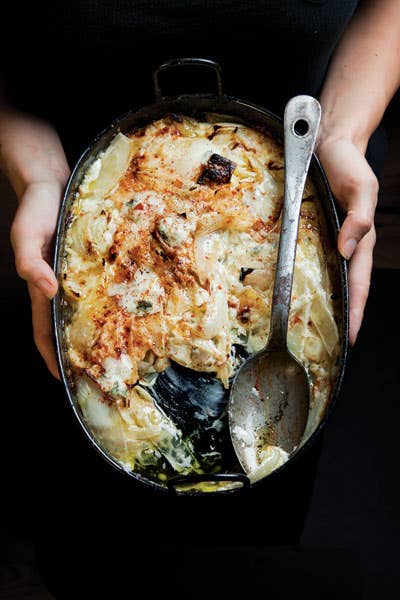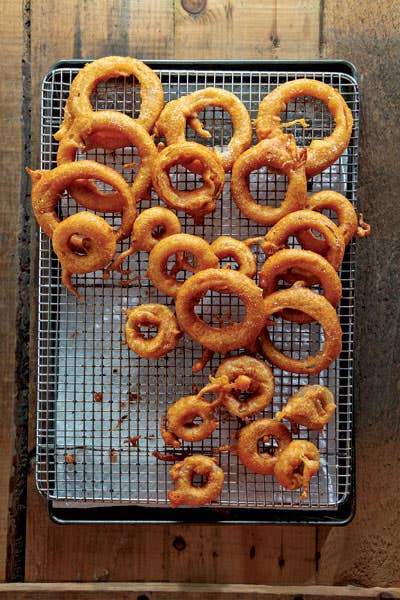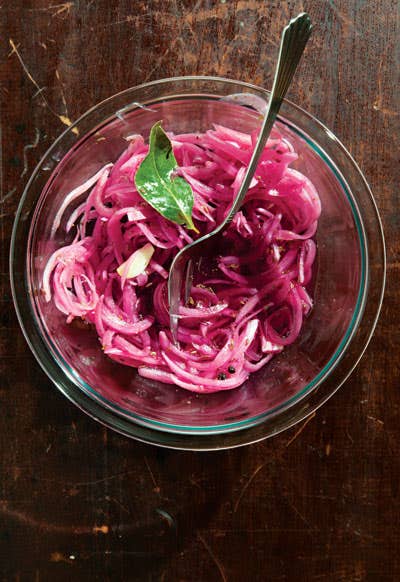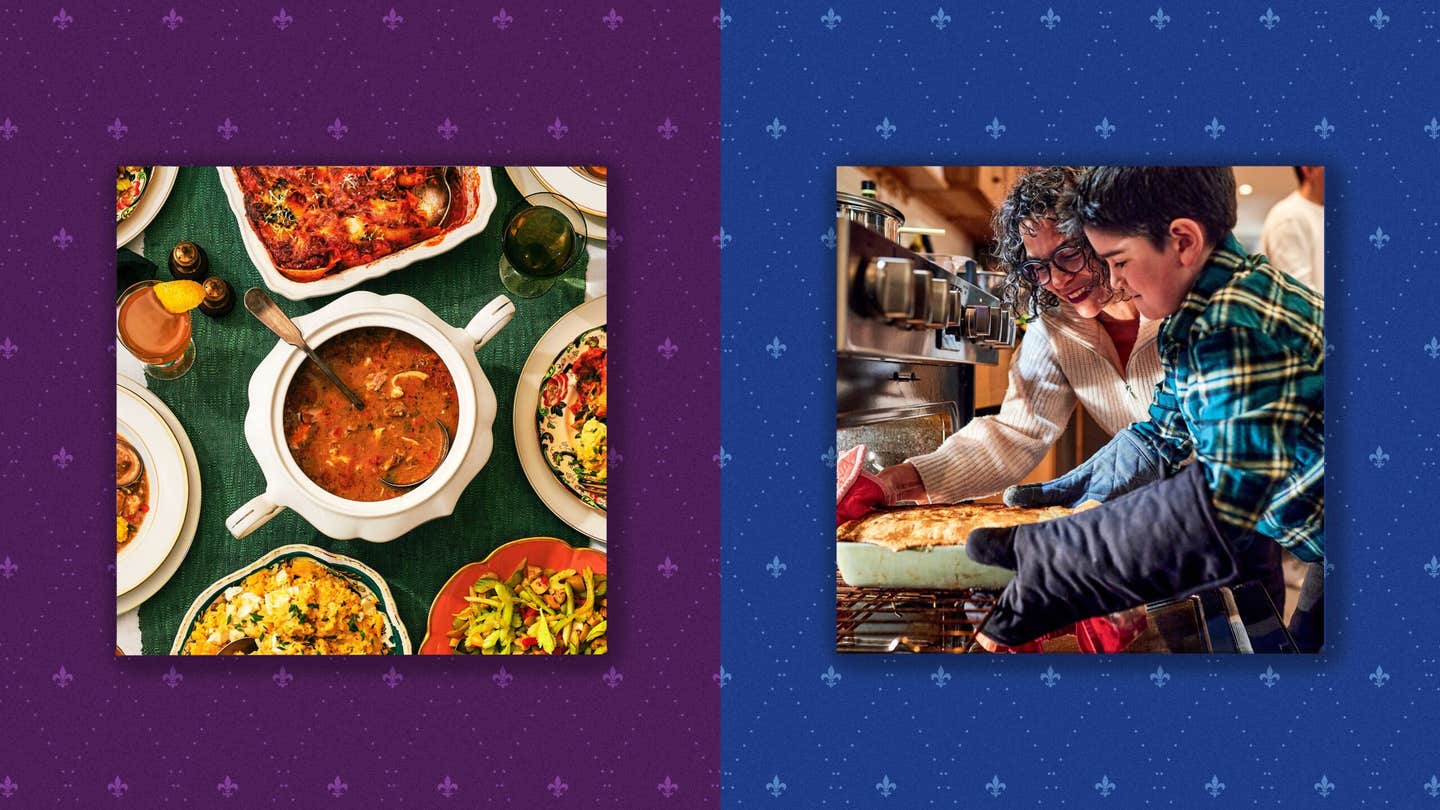
Roots of Flavor: The Versatile, Inspiring Onion
Onions are the most versatile and inspiring vegetable in our kitchens
There's a small table in my kitchen that holds a huge basket of onions: the big, juicy red ones I slice for salads; the amber, satiny supermarket ones, still in their red fishnet bag; a handful of flat cippoline from the farmers' market, each one the size and a shape of a doorknob. There are always purple-tinged shallots in the mix, and if you dig around, you'll probably find a few pearl onions left over from the last time I made coq au vin.
Just looking at this basket makes me feel like cooking. A roast chicken, one with lots of quartered onions to catch the drippings; or burgers, pan-fried into a heap of slivered onions that have turned crisp and brown. Or those cippoline, caramelized in a curry until their insides are like butter. As long as this basket is full, there is always something delicious to eat.
I recently encountered one of the prettiest onions I've ever seen on my friend Shannon's kitchen counter in upstate New York: It was pale yellow, about the size of a grapefruit, but tapered at the top and covered with a thin sheath of papery skin. It felt great in my hand—heavy and solid—and when she sliced into it, it nearly burst with sweet, spicy juice. Shannon, a fantastic cook from South Carolina, had the good sense to drench those slices with olive oil and throw them on the grill as she was cooking steak; when they came off, they were glossy tangles, creamy and luscious, the perfect accompaniment to the grilled meat.
It occurred to me, eating that exquisite onion, just how much I take these bulbs for granted. I can name a dozen diff erent heirloom tomatoes or apples I've sought out over the years, and I can tell you which ones are best for what recipes, but not so when it comes to this ingredient that works so hard in my kitchen. Aside from the sweet Spanish onions you find at any supermarket, and the Vidalias from Georgia and mild Walla Wallas from Washington State that make a seasonal appearance each summer, I don't know much about onion varieties, their season, or how they're grown and stored. Why was this onion, which Shannon received in her CSA box from a local farm, as juicy as the young, waxy-skinned onions with green tops that I buy at the farmers' market each spring? What made it so unbelievably delicious?
A few weeks after that late summer dinner at Shannon's, I was standing in Andy Szymanowicz's greenhouse on a farm in the hills of Ancramdale, in New York's Hudson Valley. I had tracked the 32-year-old farmer down through Sol Flower Farm, where Shannon gets her produce, and through chefs in the area who swore by Szymanowicz's organically raised onions. Two long tables set up on cinder blocks were covered with thousands upon thousands of them, skins caked with dirt and stems shriveled dry. The air was heavy with wet earth and raw onion.
"Onions aren't easy," the farmer told me. "They're slow growing, so I plant different varieties to be ready at different stages of the season." Early in the spring, he sells varieties that are pulled when their stems are still green and their bulbs are glossy and white. Come summer, he harvests sweet varieties that have developed a tougher skin and can be stored for short periods, like the ones I fell in love with at Shannon's house, an heirloom called Ailsa Craig. By the time I made it to his farm, those were gone, and he was curing onions, drying them out in that greenhouse so they will last through the winter without getting moldy or soft—standard practice for storing onions. Still, these looked nothing like the small red or yellow ones you get in two-pound bags at the supermarket, the kind that dominates the onion industry in this country. "These are Red Bulls," he said, pulling off a few purple leaves from a specimen that could have easily weighed a pound on its own. "They're my best red storage onion."
Creamed Onion Gratin
Sweet, translucent roasted onions marry beautifully with bechamel and Gorgonzola in this rich casserole. Get the recipe for Creamed Onion Gratin »
Photo: Todd Coleman
If you take a look at any seed catalog, you'll notice lots of onion varieties you've probably seen but never heard of—Australian brown, Tropeana lunga, red Welsh, copra, and these Ailsa Craigs, a variety developed in the late 19th century by a Scottish farmer to compete with the sweet Bermuda onion, which was all the rage at the time. Until the seeds of Bermuda onions were shipped to the States in 1898, and until hybridizing technology in the 1920s allowed for botanists to develop sweeter varieties of onions that could grow in cool climes, the bulb onions most Americans knew were the sharper-flavored ones that grew in the Northeast, which were descendants of varieties brought over from the Old World by early colonists.
The kind of onions we're talking about here are bulb onions belonging to Allium cepa, a species that's been cultivated since ancient times and now is grown around the world. Allium cepa includes scallions, also called green onions; they're essentially onions that have not yet developed their bulbs. The same species also includes pearl, boiling, and baby onions, which, interestingly, aren't just smaller varieties (though some have been selected not to get too big) or ones harvested before they've matured. They're Allium cepa sowed in densely planted patches, so that they don't have room to grow any bigger than large gum balls. Shallots, which can resemble garlic but contain just a couple cloves, are a variety of Allium cepa called ascalonicum; there's a larger, sharp flavored variety popular in French cooking and a smaller, sweeter one that's the allium of choice in southeast Asia. Garlic, leeks, chives, and ramps all belong to different branches of the Allium family tree.
What distinguishes Allium cepa from those other types are their bulbs —essentially swollen leaf bases containing energy in the form of sugars, which help the plant shoot up a stalk for a new plant the next season. It's what's inside those leaves that make onions so important in the kitchen: They contain volatile compounds that drastically change when the bulb is sliced and exposed to air, heat, and other elements. "The key to the onion family's appeal is a strong, often pungent, sulfury flavor whose original purpose was to deter animals from eating the plants," writes Harold McGee in On Food and Cooking (Scribner, 2004). In one of the best descriptions of the science of onions written for cooks, McGee explains that the onion takes up sulfur from the soil, and the sulphuric compounds it forms float in the cell fluid until they are, via cutting and cooking, unlocked by the cook (whose first response may be shedding tears, a reaction to sulfur gasses, which can be reduced by chilling the onions for 30 minutes before slicing them).
The fact that onions take their sulfur from the soil explains why certain regions produce sweeter, or milder, onions than others. Vidalias, Texas 1015s, and Mauis do not refer to specific cultivars; they're all white or red grano or granex types, sweet onion varieties that are grown in, and often named for, regions where the sulfur content of the soil is low. Sweet onions are usually sold fresh for short-term storage; the spicier ones, which tend to contain less juice and therefore have a longer shelf life, are cured and stored.
Beer-Battered Onion Rings
A flavorful batter infused with honey, paprika, and lager beer is the secret to these crunchy onion rings. Get the recipe for Beer-Battered Onion Rings »
Photo: Todd Coleman
Nowadays, there are thousands of cultivars that range in color (brown, yellow, red, white), flavor (sweet, spicy, mild), shape (globes, teardrops, torpedos), and adaptability to different growing conditions (see "Global Flavor," article, linked below). Every region has its onions; every onion, its terroir.
Once you realize that onions contain such a complex mix of sugars and aromatic compounds, it's easy to see why they provide the foundation of flavor to so many of the world's cuisines. It's the transformative nature of these elements in onions that makes them among the most versatile, and inspiring, ingredients in the kitchen.
When I was learning to cook in my Italian-American family, dinner always began with onions (and often garlic) sweating, or cooking over low heat, in olive oil. Back then, I never thought about what was happening on a chemical level—that the sugars in the onions were turning even sweeter because of the heat; that the oil would carry the flavor of the onions throughout the rest of the dish—but as I started reading cookbooks, it became clear that cooks take pains to describe exactly how onions should be cooked: translucent, or golden, or browned. When I was working on a cookbook with the Venetian chef Mara Martin years ago, she would correct me while I was translating her recipes. "Browned is too much!" she insisted—but gold was not enough. "Abbronzate," she'd say in Italian. Bronzed. It's the difference between what the Italians call a battuto—a base of onions, with celery, carrots, and other seasonings that's briefly cooked in the beginning stages of a soup, a sauce, a risotto—and a soffritto, where the onions are taken to a deeper level of gold. All across the globe, cooks start dishes this way: There's the French mirepoix of onions, celery, and carrots; the Cajun trinity of onions, peppers, and celery; the way southeast Asian cooks start curries and other dishes by slowly cooking a spice paste made with aromatics and lots of minced shallots; or how Middle Eastern cooks sweat onions in fat and then add dry spices. When I was in Morocco I learned to start a tagine by cooking onions with saffron in a pan and then transfer them to the oven, where their flavors mingled as they stewed with other ingredients, like chicken and olives and lemons.
Sweating is only one way that cooks manipulate onions. When I was working in restaurants, it was always someone's job to come in early in the morning to slice a huge bagful of onions and stir them over low heat with lots of butter until they were caramelized. Again, I didn't know then that the sugars were intensifying and the cell walls were breaking down, but I knew some sort of magic was happening, causing these sharp, raw onions to turn into a kind of luscious onion essence we stirred into risottos, dolloped into soups, slathered onto bruschetta and pizza and more. This was the '90s, when caramelized onions were in everything—for good reason, I'd argue. To this day, they are the secret weapon in my kitchen, and I often make them without any particular recipe in mind. To me, caramelizing onions is one of the most pleasurable acts of cooking, the standing and stirring and staring into the pot, inhaling the subtle changes in aroma from sweet to sweeter. When I've finished, I'm not far from onion soup, onion-topped bialys, French onion dip, or any number of delicious things.
The way different cultures work with onions is a testament to the bulb's overwhelming versatility, not to mention the creativity of cooks. Onions have a history of being pickled, or added to pickles, because the flavonoid compounds they contain are natural preservatives, which may explain why dishes like escabeche, the marinated fried fish dish that originated in the Mediterranean, is literally swimming in onions. When onions themselves are pickled, the flavor of the brine penetrates the bulb, which is why I love making my own cocktail onions with fresh thyme and vermouth.
Photo: Todd Coleman
Raw onions are an altogether different pleasure. When I get lunch at my favorite Punjabi place in Manhattan, called Minar, I love that I'm handed a tinfoil-wrapped square of onion slices; they're a refreshing foil to the spicy, stewed foods. That burst of bright flavor is the same thing that makes onions in salads and tacos and gyros so fantastic.
On the other end of the spectrum are fried onions. One of the best culinary lessons I've picked up from our editor-in-chief, James Oseland, is crisp-frying shallots until they take on an almost meaty sweetness to make a condiment called bawang goreng in Indonesia. In the office, we sprinkle them into soups, curries, stir-fries, and bowls of rice. I am a sucker for good onions rings, too, though they have a cushion of batter, so the onion itself has a lighter flavor, more akin to how it tastes when boiled or braised.
When I said good-bye to Andy Szymanowicz at Sol Flower Farm, he handed me a bunch of heavy Red Bull onions by their stalks and told me to enjoy. I felt compelled to find the right dish for these beautiful onions, and asked the farmer what he liked to do with them. "I love them caramelized and sauteed with kale," was his answer.
In the past, I would never have thought to caramelize red onions: roasting with a topping of bread crumbs, yes; sauteing with zucchini, sure. But if I have learned anything about onions it is this: While I might not want to put a sharp supermarket onion on my sandwich, when it comes to cooking, it doesn't much matter which you use. Onions rarely let you down, especially the good ones. And my dinner that night was fantastic.
Keep Reading
Continue to Next Story













